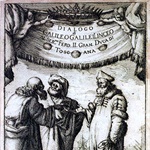Applying Research in STEM Classrooms Concretely - Sharing Inspiration 2021
 In 2021, our biennial conference Sharing Inspiration will go virtual. For the first time Sharing Inspiration also offers year-round activities for teachers, such as quarterly conferences and monthly webinars. On January 21, the first of these quarterly conferences was held. Read a report on this conference which focused on ‘Applying Research in STEM Classrooms Concretely.’
In 2021, our biennial conference Sharing Inspiration will go virtual. For the first time Sharing Inspiration also offers year-round activities for teachers, such as quarterly conferences and monthly webinars. On January 21, the first of these quarterly conferences was held. Read a report on this conference which focused on ‘Applying Research in STEM Classrooms Concretely.’
How research into mathematics and science education affects the classroom
More than 100 people logged into part 1 of Sharing Inspiration 2021. Listeners were allowed two short breaks during the 3.5-hour session during which we heard from three areas of research and its application to classroom teaching.
1. Professor Katja Maass on how contemporary events make their demands felt upon mathematics education today with supporting research.
After teasing us with a discussion between Salviati and Simplicio from Galileo's Dialogues, about the purpose of mathematics education Katja Maass outlined what we can learn from the current Covid-19 pandemic. She highlighted the necessity of doing not only mathematical modelling in class but also the modelling of societal and controversial issues which include analyzing sources, discussing possibly controversial solutions and taking into account ethical, moral, political and economic aspects. She then developed the ideas and research behind modelling and described three principal approaches to the task. The first used Inquiry Based Learning, with little change to practice. The second saw modelling as simply a collection of pedagogical practices applicable to all lessons, while the third considered that students should engage in modelling as part of the whole cycle of the scientific process. The final challenge to us all was to consider the modelling of controversial and contemporary issues as an essential part of a mathematics education.
Katja then asked me (Ian Galloway acting as Simplicio) what research might say about the demands that mathematics places on science education today. I outlined three vignettes about the difficulties of using vectors in science education, including a mathematical description of Kepler’s second law using vectors courtesy of Richard Feynman. His challenge to us all was to suggest that we do not integrate the vector algebra model sufficiently well into our science teaching and this leads to poor understanding of basic physical phenomena particularly in kinematics, mechanics and universal gravitation.
2. Professor Gultekin Cakmakci spoke about his research into aspects of good STEM teaching and how we might motivate learners through our selection of appropriate STEM activities.
Gultekin Cakmakci presented a clear and coherent argument for introducing the affective domain in our teaching. He gave examples of how we could bring this into our teaching no matter what curriculum was being followed, describing various ways in which a holistic STEM education could be delivered.
Gultekin addressed the following questions:
- What are the criteria for a good STEM activity?
- What would be the outcomes of this activity and how can we assess a STEM activity?
- Do you think this is a STEM activity?
- How can we spur students’ motivation and scientific thinking?
- Which learning theories best form the basis of STEM education?
There was a clear focus on the skills which will be needed if we adopt an engineering type of approach to problem solving, and the challenge to us all was how to introduce different disciplines into the curriculum across the whole spectrum of interdisciplinary methods.
3. In the third part of the conference Dr Helmut Heugl and Professor Simon Plangg discussed the role of technology in mathematics teaching today.
While Helmut Heugl talked about multiple representations and CAS Simon Plangg showed us how dynamic geometry could be used to help with understanding vector algebra and then went on to discuss repetitive and elaborative learning strategies with some concrete examples.
Helmut extended the idea of modelling Covid-19 from Katja’s introduction to using the power of multiple representations within TI-NspireTM to explore the development of the virus during different lockdowns. He also gave us an example of CAS being used to investigate the uptake of medicines by the body using a Bateman function, something which would otherwise be very arduous when solved numerically. Simon demonstrated the use of dynamic geometry for exploring vector algebra and the difference between iterative and elaborative learning. (Elaborative learning is about looking for deeper meaning through the relation of new knowledge to that already stored in the memory). He went through a number of examples using 3-dimensional geometry to explain their ‘module learning principle’. Simon and Helmut also revealed the research behind their work to show the impact that using technology has on improving the learning of students.
For further information contact:
Dr. Katja Maass
Ian Galloway
Dr. Gultekin Cakmakci
Helmut Heugl
Mag. Dr. Simon Plangg
